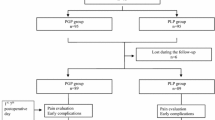Abstract
The purpose of this study was to compare a lightweight mesh to a standard polypropylene hernia mesh in endoscopic extraperitoneal hernioplasty in recurrent hernias. A total of 140 men with recurrent unilateral inguinal hernias were randomised to a totally extraperitoneal endoscopic hernioplasty (TEP) with Prolene or VyproII in a single-blinded multi-center trial. The randomisation and all data handling were performed through the Internet. 137 patients were operated as allocated. Follow-up was completed in 88% of the patients. The median operation times were 55 (24–125) min and 53.5 (21–123) min for the Prolene and VyproII groups, respectively. The meshes had comparable results in the surgeon’s assessment of the handling of the mesh, return to work, return to daily activities, complications, postoperative pain and quality of life during the first 8 weeks of rehabilitation, except in General Health (GH) SF-36, where the VyproII-group had a significantly better score (P=0.045). The use of Prolene and VyproII-meshes in endoscopic repair of recurrent inguinal hernia seems to result in similar short-term outcomes and quality of life.




Similar content being viewed by others
References
Haapaniemi S, Gunnarsson U, Nordin P, Nilsson E (2001) Reoperation after recurrent groin hernia repair. Ann Surg 234:122–126
Collaboration EHT (2002) Repair of groin hernia with synthetic mesh: meta-analysis of randomized controlled trials. Ann Surg 235:322–332
Kumar S, Wilson RG, Nixon SJ, Macintyre IM (2002) Chronic pain after laparoscopic and open mesh repair of groin hernia. Br J Surg 89:1476–1479
Frankum CE, Ramshaw BJ, White J, Duncan TD, Wilson RA, Mason EM, Lucas G, Promes J (1999) Laparoscopic repair of bilateral and recurrent hernias (discussion 842–843). Am Surg 65:839–842
Kumar S, Nixon SJ, MacIntyre IM (1999) Laparoscopic or Lichtenstein repair for recurrent inguinal hernia: one unit’s experience. J R Coll Surg Edinb 44:301–302
Tamme C, Scheidbach H, Hampe C, Schneider C, Kockerling F (2003) Totally extraperitoneal endoscopic inguinal hernia repair (TEP). Surg Endosc 17:190–195
Klinge U, Klosterhalfen B, Muller M, Schumpelick V (1999) Foreign body reaction to meshes used for the repair of abdominal wall hernias. Eur J Surg 165:665–673
Junge K, Klinge U, Rosch R, Klosterhalfen B, Schumpelick V (2002) Functional and morphologic properties of a modified mesh for inguinal hernia repair. World J Surg 26:1472–1480
Klinge U, Klosterhalfen B, Muller M, Anurov M, Ottinger A, Schumpelick V (1999) Influence of polyglactin-coating on functional and morphological parameters of polypropylene-mesh modifications for abdominal wall repair. Biomaterials 20:613–623
Junge K, Klinge U, Prescher A, Giboni P, Niewiera M, Schumpelick V (2001) Elasticity of the anterior abdominal wall and impact for reparation of incisional hernias using mesh implants. Hernia 5:113–118
Welty G, Klinge U, Klosterhalfen B, Kasperk R, Schumpelick V (2001) Functional impairment and complaints following incisional hernia repair with different polypropylene meshes. Hernia 5:142–147
Sullivan M, Karlsson J (1994) SF-36 Hälsoenkät Manual och tolkningsguide, Sahlgrenska sjukhuset, Göteborg, Sweden
Sullivan M, Karlsson J (1998) The Swedish SF-36 Health Survey III. Evaluation of criterion-based validity: results from normative population. J Clin Epidemiol 51:1105–1113
Matlaga BF, Salthouse TN (1983) Ultrastructural observations of cells at the interface of a biodegradable polymer: Polyglactin 910. J Biomed Mater Res 17:185–197
Bringman S, Heikkinen TJ, Wollert S, Osterberg J, Smedberg S, Granlund H, Ramel S, Fellander G, Anderberg B (2004) Early results of a single-blinded, randomized, controlled, Internet-based multicenter trial comparing Prolene and Vypro II mesh in Lichtenstein hernioplasty. Hernia 8:127–134
Bringman S, Wollert S, Österberg J, Smedberg S, Granlund H, Felländer G, Heikkinen T (2004) One year results of a single-blinded, randomised, controlled, Internet-based multi-centre trial comparing Prolene and VyproII-mesh in Lichtenstein hernioplasty. Hernia (submitted)
McCormack K, Scott NW, Go PM, Ross S, Grant AM (2003) Laparoscopic techniques versus open techniques for inguinal hernia repair. Cochrane Database Syst Rev:CD001785
Neumayer L, Giobbie-Hurder A, Jonasson O, Fitzgibbons R, Jr., Dunlop D, Gibbs J, Reda D, Henderson W (2004) Open mesh versus laparoscopic mesh repair of inguinal hernia. N Engl J Med 350:1819–1827
Ramshaw B, Shuler FW, Jones HB, Duncan TD, White J, Wilson R, Lucas GW, Mason EM (2001) Laparoscopic inguinal hernia repair: lessons learned after 1224 consecutive cases. Surg Endosc 15:50–54
Ramshaw BJ, Tucker JG, Conner T, Mason EM, Duncan TD, Lucas GW (1996) A comparison of the approaches to laparoscopic herniorrhaphy. Surg Endosc 10:29–32
Felix EL, Michas CA, Gonzalez MH Jr (1995) Laparoscopic hernioplasty. TAPP vs TEP. Surg Endosc 9:984–989
Heise CP, Starling JR (1998) Mesh inguinodynia: a new clinical syndrome after inguinal herniorrhaphy? J Am Coll Surg 187:514–518
Poobalan AS, Bruce J, Smith WC, King PM, Krukowski ZH, Chambers WA (2003) A review of chronic pain after inguinal herniorrhaphy. Clin J Pain 19:48–54
Callesen T, Bech K, Kehlet H (1999) Prospective study of chronic pain after groin hernia repair. Br J Surg 86:1528–1531
Collaboration EH (2000) Laparoscopic compared with open methods of groin hernia repair: systematic review of randomized controlled trials. Br J Surg 87:860–867
Acknowledgements
The authors are grateful to RN Cajsa Barthelsson, RN Christina Lindblom, RN Sirpa Jämsä and secretary Lise-Lotte Lindh for their skillful work on the study. The study was supported by a grant from Ethicon Scandinavia and from the County Council of Stockholm.
Author information
Authors and Affiliations
Corresponding author
Rights and permissions
About this article
Cite this article
Heikkinen, T., Wollert, S., Österberg, J. et al. Early results of a randomised trial comparing Prolene and VyproII-mesh in endoscopic extraperitoneal inguinal hernia repair (TEP) of recurrent unilateral hernias. Hernia 10, 34–40 (2006). https://doi.org/10.1007/s10029-005-0026-6
Received:
Accepted:
Published:
Issue Date:
DOI: https://doi.org/10.1007/s10029-005-0026-6




